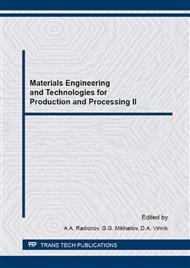[1]
S.V. Morin, A comprehensive study of vibration exposure on the crystallization and properties of castings of aluminum alloys, Ph.D. diss., SibGIU, Novokuznetsk, (2005).
Google Scholar
[2]
V.A. Efimov, A.S. Eldarkhanov, Physical methods of influence on the processes of solidification of alloys, Metallurgiya, Moscow, (1995).
Google Scholar
[3]
G.N. Minenko, About energy impact on metal melt, Metallurgy of Machinery Building. 3 (2006) 10-12.
Google Scholar
[4]
V.L. Naidek, A.S. Eldarkhanov, A.S. Nuradinov, E.D. Taranov, The effect of vibration on the structure and properties of AK5M2 aluminum alloy, Russian Foundrymen. 10 (2005) 23-25.
Google Scholar
[5]
V.I. Dobatkin, G.I. Eskin, Ultrasonic treatment of molten non-ferrous metals and alloys, Nauka, Moscow, (1986).
Google Scholar
[6]
A.I. Batyshev, Crystallization of metals and alloys under pressure, Metallurgiya, Moscow, (1977).
Google Scholar
[7]
Information on http: /www. iipt. com. ua/news/news_5. htm.
Google Scholar
[8]
E. Kh. Rhi, S.V. Dorofeev, V.I. Yakimov, Influence of an exposure of liquid phase to nanosecond electromagnetic pulses on its structure, crystallization, structure and properties of casting alloys, Dal'nauka, Vladivostok, (2008).
Google Scholar
[9]
L.A. Verte, Magnetic hydrodynamics in metallurgy, Metallurgiya, Moscow, (1975).
Google Scholar
[10]
Y.A. Samoylovic, Crystallization of the ingot in the electromagnetic field, Metallurgiya, Moscow, (1986).
Google Scholar
[11]
A.V. Dorofeev, A.B. Kilin, A.S. Tertishnikov, Treatment of aluminum melts by electric current, Russian Foundrymen. 2 (2002) 19-21.
Google Scholar
[12]
V.I. Yakimov, V.I. Shport, V.I. Murav'ev, A.T. Kalinin, A.V. Yakimov, The impact of DC on the quality of magnesium alloy, Litejnoe proizvodstvo. 2 (1999) 10-12.
Google Scholar
[13]
S.L. Timchenko, N.A. Zadorozhniy, The influence of electric current on the crystallization of aluminum alloy, Litejnoe proizvodstvo. 9 (2005) 12-13.
Google Scholar
[14]
A.A. Lyubimov, A.S. Tertishnikov, Electromagnetic method of producing ingots, Metallurgy of Machinery Building. 4 (2004) 32-36.
Google Scholar
[15]
A.P. Lychev, A.I. Cheremisin, The crystallization of metals in an external magnetic field, Izvestija vuzov: Chernaya metallurgija. 11 (1978) 158-161.
Google Scholar
[16]
V.I. Dubodelov, S.M. Zakharov, V.F. Mazanko, V.M. Mironov, A.V. Mironov, The influence of alternating magnetic field on diffusion in liquid aluminum, Materialovedenie. 12 (2003) 27-29.
Google Scholar
[17]
P.P. Mochalov, Z.N. Getselev, Casting in electromagnetic crystallisers, Tsvetnye Metally. 8 (1970) 62-63.
Google Scholar
[18]
E.G. Chugunniy, Magnetoimpulse processing of crystallizing melts, Litejnoe proizvodstvo. 1 (1996) 12-13.
Google Scholar
[19]
V.A. Glouschenkov, F.V. Grechnikov, V.I. Nikitin, D.G. Chernikov, A.Y. Igolkin, K.V. Nikitin, A.A. Pozdnyakov, The effect of pulsed magnetic field of high density on the properties of liquid aluminium alloys, Russian Foundrymen. 7 (2010) 34-39.
Google Scholar
[20]
D.G. Chernikov, V.A. Glouschenkov, F.V. Grechnikov, A.Y. Igolkin, V.I. Nikitin, K.V. Nikitin, About magnetic pulse treatment of molten silumin АК9Т, Litejnoe proizvodstvo. 9 (2011) 8-11.
Google Scholar
[21]
V.A. Glouschenkov, Y.A. Egorov, A.Y. Igolkin, D.G. Chernikov, RU Patent 2311989. (2007).
Google Scholar
[22]
V.A. Glouschenkov, A. Ju. Igolkin, D.G. Chernikov, V.I. Nikitin, B.V. Vyalov, Forming of structure and properties of multi-phase alloys under action of a high-intensity pulsed-magnetic field, in: Proceeding of Multi-phases and multi-components materials under dynamic loading: Materials of 10th European Mechanics of Materials Conference, Kazimierz Dolny, Poland. (2007).
Google Scholar
[23]
V.A. Glouschenkov, F.V. Grechnikov, A. Ju. Igolkin, D.G. Chernikov, Action of pulse-magnetic fields on liquid and crystallizing metal, Prospects for development of new technologies, in: Proceeding of ICHSF-2008: Materials of 3rd International Conference on Highspeed Forming, Dortmund, Germany. (2008).
Google Scholar
[24]
V.A. Glouschenkov, D.G. Chernikov, F.V. Grechnikov, V.A. Kostyshev, A. Ju. Igolkin, R. Yu. Yusupov, A.P. Popov, A possibility of forming structure and mechanical properties of aluminum alloys by the action of the pulse-magnetic field on a melt, in: Proceeding of Materials of 11th International Conference on Aluminum Alloys, Aachen, Germany. (2008).
Google Scholar
[25]
K.V. Nikitin, E.A. Amosov, V.I. Nikitin, V.A. Gloushchenkov, D.G. Chernikov, Theoretical and experimental substantiation of treatment of aluminum-based melts by pulsed magnetic fields, Russian Journal of Non-Ferrous Metals. 6 (2015) 599-605.
DOI: 10.3103/s1067821215060085
Google Scholar
[26]
F.V. Grechnikov, E.G. Demyanenko, I.P. Popov, Development of technology for obtaining aluminium alloys of high strength and high electrical conductivity, Izvestija vuzov: Cvetnaja metallurgija. 6 (2014) 17-21.
Google Scholar
[27]
A.M. Bibikov, F.V. Grechnikov, G.E. Goldbukht, E.G. Demyanenko, I.P. Popov, Principles of alloying deformable nanostructured conductor aluminum alloys, Mashinostroenie: Metallurgija. 5 (2013) 9-14.
Google Scholar


